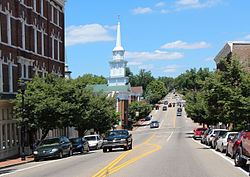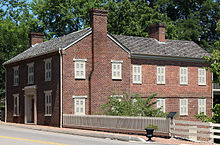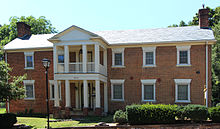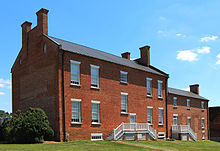United States historic place
| Greeneville Historic District | |
| U.S. National Register of Historic Places | |
| U.S. Historic district | |
 Main Street, Greeneville, Tennessee Main Street, Greeneville, Tennessee | |
  | |
| Location | Roughly bounded by Irish, Nelson, E. Church, College and McKee Sts., Greeneville, Tennessee |
|---|---|
| Area | 135 acres (55 ha) |
| Architect | Multiple |
| Architectural style | Greek Revival, Late Victorian, Federal |
| NRHP reference No. | 74001913 |
| Added to NRHP | May 3, 1974 |
Greeneville, the county seat of Greene County was established in the late eighteenth century, and is one of the most important towns in historic East Tennessee. Although many of the early buildings have been destroyed, there remain yet a large number of buildings important from either a historical or architectural standpoint.
The Greeneville Historic District consists of an area a block in each direction of Main Street from McKee Street to Nelson Street, comprising an area of about 135 acres containing approximately 175 structures.
Greeneville was established in 1783 around a spring, which is located almost in the heart of town. It was named in honor of General Nathanael Greene of Revolutionary War fame, and was settled by the Scotch-Irish. Its location along important early trade and stage routes caused it to become an important community in the years before the Civil War. Its citizens became prosperous enough to build substantial dwellings, and places of business, many of which form the heart of the historic district.
List of historic structures
| Name | Address | Year Built | Architectural Style | Comments |
Hotel Brumley
 |
109 North Main Street | 1884 | Unclassified | It was first called the Grand Central, and was considered to be the finest hotel "from Chattanooga to Roanoke." |
Cumberland Presbyterian Church
 |
201 North Main Street | 1860s | Greek Revival/Italianate architecture | The building was constructed on land purchased from Andrew Johnson. During the Civil War it was used as both a hospital and a stable. On September 4, 1864, it was shelled. |
First Presbyterian Church
 |
110 North Main Street | 1847 | Greek Revival | Established in 1780, this congregation is the oldest in Greeneville and had more than 1,000 members before 1790. |
Saint James Episcopal Church
 |
105 North Church Street | 1850 | Gothic Revival | It has a slave gallery and an organ which is reported to be the oldest in Tennessee. |
Valentine Sevier House
 |
214 North Main Street | 1822 | Federal | Built by a nephew of John Sevier, Tennessee's first governor. |
W. H. Doughty House
 |
309 North Main Street | 1906-07 | Greek Revival | |
Antrium
 |
307 North Main Street | Circa 1800 | Log Cabin | This was built in rural Greene County and moved to its present location in 1965. |
Andrew Johnson Home
 |
217 South Main Street | Circa 1851 | Federal/Greek Revival | This was purchased by Andrew Johnson and lived in until his death, with the exception of the time he spent in Nashville and Washington D.C. as governor, congressman, senator, and president. |
Susong House
 |
202 South Main Street | 1795 | Originally a Log Cabin, subsequently covered with clapboard | This was a two-story log house built by Valentine Sevier and later covered with clapboard. It is the oldest building in Greeneville. |
Clawson-McDowell-Brown Home
 |
204 South Main Street | 1810 | Federal | |
Lowry Snapp House
 |
216 South Irish Street | Circa 1840s | Unclassified | |
Armitage-McKee Law Office
 |
Corner of McKee and Irish Streets | Circa 1860 | Unclassified | |
Dickson-Williams Mansion
 |
106 North Irish Street | Circa 1820 | Unclassified | It was perhaps the most imposing mansion in East Tennessee when it was built. During the Civil War it was used by both Union and Confederate armies as a headquarters. General Morgan spent his last night here, and was killed by Union Soldiers in the mansion's gardens. |
Other images

See also
References
- "National Register Information System". National Register of Historic Places. National Park Service. July 9, 2010.
- ^ "National Register Information System". National Register of Historic Places. National Park Service. March 13, 2009.
- ^ Harper, Herbert (April 17, 1974). "National Register of Historic Places Inventory - Nomination Form: Greeneville Historic District". National Park Service. Retrieved August 13, 2015 and photos.
External links
![]() Media related to Greeneville Historic District at Wikimedia Commons
Media related to Greeneville Historic District at Wikimedia Commons